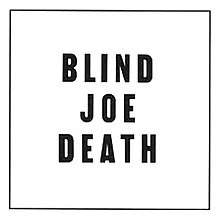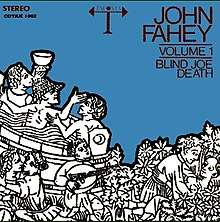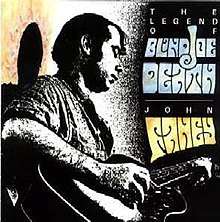Blind Joe Death
Blind Joe Death is the first album by American fingerstyle guitarist and composer John Fahey. There are three different versions of the album, and the original self-released edition of fewer than 100 copies is extremely rare.
| Blind Joe Death | ||||
|---|---|---|---|---|
 | ||||
| Studio album by | ||||
| Released | 1959 | |||
| Recorded | 1959, St. Michael's and All Angels Church, Adelphi, Maryland | |||
| Genre | American Primitivism | |||
| Length | 43:21 (1959 version) | |||
| Label | Takoma | |||
| Producer | John Fahey | |||
| John Fahey chronology | ||||
| ||||
| Alternative cover | ||||
 Cover of the 1967 stereo release of the LP (design by Tom Weller) | ||||
The recording of steel-string acoustic guitar solos was "incredibly avant-garde" in 1959. It was released on Takoma Records, Fahey's own label. It was not marketed and made no impression on the American record-buying public.[1]
Its popularity, significance in guitar music, and critical reception have grown over the years. The music historian Richie Unterberger characterized Blind Joe Death as "a very interesting record from a historical perspective...as few if any other guitarists were attempting to interpret blues and folk idioms in such an idiosyncratic fashion in the late '50s and early '60s."[2] Richard Cook of the NewStatesman wrote, "Only 100 copies were pressed. Incredibly, it was still enough of a milestone to secure him an almost worldwide reputation."[3]
On April 6, 2011, the album was deemed by the Library of Congress to be "culturally, historically, or aesthetically important" and added to the United States National Recording Registry for the year 2010.[4]
Background
Initially released in 1959 in a very limited edition, one side of the record was credited to a mythical bluesman named Blind Joe Death, while the other side was credited to Fahey himself.[5] It was one of the first albums recorded and produced by an independent artist. Self-released on Takoma Records, the label didn't formally exist until 1963 when Fahey and ED Denson formed a partnership with record distributor Norman Pierce.[6] Barry Hansen wrote in 1972, "John Fahey is the original underground musician. Dylan was still at Hibbing High School when John Fahey made his first record."[7]
Fahey's earliest recordings were released on custom edition 78-rpm discs released by Fonotone, a record company run by his friend Joe Bussard.[8][9] In 1959 Fahey made his own record, recorded in his hometown of Takoma Park, Maryland, and pressed by RCA Custom Recorders. He pressed only 100 copies using money he earned pumping gas at a local station and a loan of $300 from an Episcopal minister. Some of the copies were broken on their way from the plant and others given away to friends. Fahey sent copies to folklorists and scholars around the country. He also planted copies in record stores and Goodwill bins for lucky customers to come across. The remainder were slowly sold over a period of four years.[1][10]
The material Fahey was playing and composing was unique in 1959. As influential musicologist and friend Dick Spottswood related, "He was not someone who was going with what we perceived as the mainstream at that time. Don't forget those were the days when rhythm and blues were all of a sudden being marketed to the white audiences called by a new name, rock 'n' roll, and John certainly wasn't interested in doing any of that... he wasn't doing any of those things that people made a living at on that instrument in those days."[1]
The name for the mythical mentor came at a friend's suggestion. In an interview with Stefan Grossman in the 1980s, Fahey stated, "The reason it said "blind" is because a lot of the people I learned from were on old 78 RPM records and a lot of them were blind, and their names were Blind Willie Johnson, Blind Boy Fuller, Blind Joe Taggart, on and on, a whole bunch of them were blind. Also I was thinking, when ever you print the word 'Death' people look at it and I was thinking of record sales already even though I was only going to have a hundred copies pressed."[5] Years later Fahey related, "The whole point was to use the word 'death'." Blind Joe Death was my death instinct. He was also all the Negroes in the slums who were suffering. He was the incarnation, not only of my death wish, but of all the aggressive instincts in me."[11]
For years Fahey and Takoma continued to treat the imaginary guitarist Blind Joe Death as a real person, including booklets with their LPs containing biographical information about him including the "fact" that he had a guitar made from a baby's coffin and that he had taught Fahey to play.[12] Fahey sometimes incorporated the myth of Blind Joe into his performances, wearing dark glasses and being led by the arm onto the stage.[13][14]
Reissues
There are three different versions of Blind Joe Death. After moving to Berkeley, California, where he attended college, Fahey's career as guitarist began to take off. Having recorded a somewhat successful second album, Death Chants, Breakdowns & Military Waltzes in late 1963, Fahey decided to re-release his original efforts. However, he decided to rerecord much of the material, as he felt he had become a much better player.[2] This second pressing claims that "On Doing an Evil Deed Blues", "In Christ There Is No East or West", "The Transcendental Waterfall", and "Uncloudy Day" are 1964 rerecordings and the rest ("St. Louis Blues", "Poor Boy Long Ways from Home", "John Henry", "Desperate Man Blues", "Sun Gonna Shine in My Back Door Someday Blues", and "Sligo River Blues") are the original 1959 versions. "Uncloudy Day" was actually the same recording, as was "St. Louis Blues" in an edited version. The 1959 album contained a version of Blind Blake's "West Coast Blues", which (despite being rerecorded in 1964) was not included on the album. To fill the gap, the new version of "Transcendental Waterfall" was extended to over 10 minutes long, a glimpse of things to come.[15]
By 1967 Fahey had released a number of albums and was very successful. It was decided that his first two albums be released in stereo; they were both rerecorded, resulting in a third version of Blind Joe Death, with a new, shorter version of "The Transcendental Waterfall" and a new song, "I'm Gonna Do All I Can for My Lord".[16][17] The 1967 versions of Blind Joe Death and Death Chants, Breakdowns & Military Waltzes were actually recorded in mono and briefly released on mono LP. Later in 1967, these recordings were edited to create a stereo effect and released on stereo LPs with new artwork.
The 1959 album has only been re-issued on vinyl, under the original catalog number, Takoma K80P-4447/4448. The 1996 Fantasy/Takoma CD release, The Legend of Blind Joe Death, contains the 1964 and 1967 versions of the album, with the exception of the later, edited 1964 recording of "The Transcendental Waterfall", as mentioned above; a previously unreleased 1964 recording of "West Coast Blues" is also included.[16]
Reception
| Review scores | |
|---|---|
| Source | Rating |
| Allmusic | |
| Allmusic | |
| Musician | (not rated)[18] |
| Q Magazine | (3 stars)[19] |
| The Rolling Stone Record Guide | |
| Encyclopedia of Popular Music | |
The music critic Richie Unterberger wrote liner notes for reissues of two of Fahey's later albums. In his Allmusic review of the 1964 release of Blind Joe Death Unterberger wrote, "The album's mystique probably owes more to the 1959 record's rarity (and utter oddity in the context of its era) than the music, in which Fahey's experimental blues-folk acoustic fusion is just beginning to take shape. It remains a very interesting record from a historical perspective, however, as few if any other guitarists were attempting to interpret blues and folk idioms in such an idiosyncratic fashion in the late '50s and early '60s."[2]
The 1967 version received five stars in both editions of the Rolling Stone Record Guide.[20][22]
In its review of the 1997 reissue, Musician magazine stated, "nobody had more emotional range or profound melodic gift than John Fahey.... Fahey's taste for the weirdly dissonant when dealing with foul emotions and his fascination with tone to the occasional exclusion of almost everything else is on fuller display here."[18]
Q magazine gave the reissue three stars, calling Fahey "a superlative acoustic guitar technician capable of blending elements of country, blues and ragtime into a style that in its spare, dark, haunting beauty was uniquely his own."[19]
Legacy
On April 6, 2011, the album was deemed by the Library of Congress to be "culturally, historically, or aesthetically important" and added to the United States National Recording Registry for the year 2010.[4]
In a 2001 interview with VH1 discussing the influence and legacy of Fahey, Barry Hansen, a longtime friend and collaborator, said of Fahey's early career, "He basically started the whole idea of playing new music on traditional acoustic steel-string guitar. He was the original underground artist." The guitarist Leo Kottke said of Fahey, "John created living, generative culture. With his guitar and his spellbound witness, he synthesized all the strains in American music and found a new happiness for all of us. With John, we have a voice only he could have given us; without him, no one will sound the same."[23]
Track listing
Side one
- "West Coast Blues" (Blind Blake) – 3:13
- "St. Louis Blues" (W. C. Handy) – 5:28
- "I'm a Poor Boy a Long Ways from Home" (Barbecue Bob) – 3:12
- "Uncloudy Day" (Josiah Kelley Alwood) – 3:24
- "John Henry" (Traditional) – 3:21
- "In Christ There Is no East or West" (Episcopal Church Hymn) – 2:42
Side two
- "The Transcendental Waterfall" (Fahey) – 6:36
- "Desperate Man Blues" (arranged by Fahey) – 4:06
- "Sun Gonna Shine in My Back Door Someday Blues" (arranged by Fahey) – 3:34
- "Sligo River Blues" (Fahey) – 3:05
- "On Doing an Evil Deed Blues" (Fahey) – 4:40
1964 track listing:
- "St. Louis Blues" [edited version]
- "I'm a Poor Boy a Long Ways From Home"
- "Uncloudy Day"
- "John Henry"
- "In Christ There Is No East or West" [re-recorded]
- "The Transcendental Waterfall" [re-recorded]
- "Desperate Man Blues"
- "Sun Gonna Shine in My Back Door Someday Blues"
- "Sligo River Blues"
- "On Doing an Evil Deed Blues" [re-recorded]
1967 track listing—all tracks re-recorded:
- "On Doing An Evil Deed Blues"
- "St. Louis Blues"
- "Poor Boy Long Ways From Home"
- "Uncloudy Day"
- "John Henry"
- "In Christ There Is No East Or West"
- "The Transcendental Waterfall"
- "Desperate Man Blues"
- "Sun Gonna Shine In My Back Door Someday Blues "
- "Sligo River Blues"
- "I'm Gonna Do All I Can For My Lord"
| The Legend of Blind Joe Death | |
|---|---|
 | |
| Compilation album by | |
| Released | 1996 |
| Recorded | 1964, 1967 |
| Genre | Folk |
| Length | 75:30 |
| Label | Takoma |
Reissue track listing (1996)
- "On Doing an Evil Deed Blues" (Fahey) – 5:07
- "St. Louis Blues" (Handy) – 4:53
- "Poor Boy, Long Ways from Home" (Fahey) – 3:12
- "Uncloudy Day" (Josiah Kelley Alwood) – 3:23
- "John Henry" (Traditional) – 3:20
- "In Christ There Is No East or West" (Harry Burleigh, John Oxenham) – 2:21
- "Desperate Man Blues" (Fahey) – 4:05
- "Sun Gonna Shine in My Back Door Someday Blues" (Fahey) – 3:32
- "Sligo River Blues" (Fahey) – 3:05
- "On Doing an Evil Deed Blues" (Fahey) – 3:56
- "St. Louis Blues" (Handy) – 3:15
- "Poor Boy, Long Ways from Home" (Fahey) – 2:23
- "Uncloudy Day" (Josiah Kelley Alwood) – 2:22
- "John Henry" (Traditional) – 2:05
- "In Christ There Is No East or West" (Burleigh, Oxenham) – 2:43
- "Desperate Man Blues" (Fahey) – 3:58
- "Sun Gonna Shine in My Back Door Someday Blues" (Fahey) – 4:39
- "Sligo River Blues" (Fahey) – 2:33
- "I'm Gonna Do All I Can for My Lord" (Fahey) – 1:24
- "The Transcendental Waterfall" (Fahey) – 10:36
- "West Coast Blues" (Fahey) – 1:25
Personnel
- John Fahey – guitar
- Pat Sullivan – engineer (1959 version)
Production notes
- Bill Belmont – compilation producer
- ED Denson – producer, liner notes for 1967 reissue
- Glenn Jones – compilation liner notes
- Joe Tarantino – compilation remastering
- Tom Weller – art direction, cover art for 1964 and 1967 reissues
References
- Miller, Dale (1992). "Reinventing the Steel". Acoustic Guitar (January/February): 46. Retrieved April 12, 2010.
- Unterberger, Richie. "Blind Joe Death > Review". Allmusic. Retrieved January 26, 2010.
- Cook, Richard (January 2000). "No words can express > Review". New Statesman: 137.
- "About This Program | National Recording Preservation Board | Programs at the Library of Congress". Loc.gov.
- Grossman, Stefan (1980s). "John Fahey Interview". Archived from the original on May 12, 2010. Retrieved April 12, 2010.
- Dunlap Jr., David (July 7, 2006). "The Cosmos Club". Washington City Paper. Archived from the original on 2006-08-12. Retrieved March 10, 2010.
- Coley, Byron (May 2001). "The Persecutions and Resurrections of Blind Joe Death". Perfect Sound Forever. Archived from the original on January 4, 2010. Retrieved March 28, 2010.
- Dean, Eddie (February 12, 1998). "Desperate Man Blues: Record collector Joe Bussard parties like it's 1929". Washington City Paper. Retrieved May 8, 2009.
- Dean, Eddie (March 9–15, 2001). "In Memory of Blind Thomas of Old Takoma". Washington City Paper. Archived from the original on 2003-02-12. Retrieved January 5, 2010.
- According to The Rolling Stone Record Guide (first edition, 1979), "there were only ninety-five copies of the record available for distribution." The Guide assigned the record 5 stars out of 5.
- Pouncey, Edwin (August 1998). "Blood on the Frets". The Wire (174). Retrieved March 15, 2010.
- Fahey, John. "Original Liner Notes: Death Chants, Breakdowns, and Military Waltzes". Takoma Records. Retrieved January 5, 2010.
- Sullivan, John Jeremiah (2009). Best Music Writing 2009: Unknown Bards. Seal Press. p. 29. ISBN 978-0-306-81782-3.
- Gordon, Robert (2001). It Came From Memphis. Simon and Schuster. p. 128. ISBN 978-0-7434-1045-8.
- "The Fahey Files - John Fahey - Notes on the Songs - Blind Joe Death". Johnfahey.com.
- Unterberger, Richie. "The Legend of Blind Joe Death > Review". Allmusic. Retrieved March 6, 2009.
- Guerrieri, Claudio (2013). The John Fahey Handbook, Vol. 1. ISBN 978-0-9853028-0-1.
- "The Legend of Blind Joe Death – Review". Musician: 90. March 1997.
- "The Legend of Blind Joe Death – Review". Q: 137. July 1996.
- Marsh, Dave; Swenson, John (Editors). The Rolling Stone Record Guide, 1st edition, Random House/Rolling Stone Press, 1979, p. 124, 598.
- Larkin, Colin (2007). Encyclopedia of Popular Music (4th ed.). Oxford University Press. ISBN 978-0195313734.
- 5-Star Albums Listing. Rolling Stone Record Guide. 2nd ed. 1983.
- Gehr, Richard. "Tormented Genius John Fahey Had Rekindled Creative Fire". VH1. Retrieved March 29, 2009.
- "Vol+01+0a.jpg (image)". Bp3.blogger.com.
- "Vol+01+0b.jpg (image)". Bp3.blogger.com.